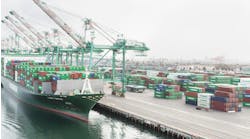Blockchain’s Impact on Food Safety, Sustainability and the Supply Chain
Improved food safety and sustainability are two priorities for today’s supply chain leaders, but achieving those goals is increasingly complex. One of the main challenges is that consumables pass through various countries, states and handling partners before reaching their destinations. The longer and more intricate those journeys are, the more difficult it can be to prevent spoilage, missing items and other problems that could contribute to foodborne illnesses and product waste.
Fortunately, numerous real-life cases strongly suggest that blockchain could make the modern food chain safer and more sustainable. Once leaders hear about the possibilities, many will be more open to implementing the technology into their workflows.
Increasing Customer Transparency
Although most food shoppers hope to find delicious choices, their priorities span beyond taste. Consider the results of a 2023 report that found 76% of respondents want information about foods’ ingredients and production processes. Additionally, 46% of those surveyed indicated that they typically look for more information about food items before purchasing them. That shows how the accurate details associated with some possibilities could cause them to purchase specific items over others.
Another takeaway was that 43% of respondents want ingredient sourcing information, while 40% would like to see ingredient production content. Notably, more than 80% of people taking part said they would be willing to use a QR code, website or another digital resource to learn more about the products, whether they shop online or in stores.
The blockchain can meet those needs and others. One example is a Hungarian tech company with a decentralized system that gathers production data from each food manufacturing stage. The parties overseeing that information eventually transfer it to consumer landing pages.
Then, purchasers can scan QR codes to learn more about the products. This system keeps them informed and gives companies details about the consumers, helping marketing teams and other relevant groups understand who purchases specific items and what drives their motivations.
Additionally, the tech company’s representatives have enticed government authorities, enabling them to secure several contracts for national-level support. One of those endeavors contributed to reducing the effects of an African swine fever outbreak in 2019.
Food shoppers want to know more about what they buy and its origins. They know such information could keep them safe and empower them to select products that align with their sustainability ideals. Although additional tech innovations have some similar advantages, the blockchain’s decentralized, immutable nature could further earn consumers’ trust.
Keeping Food Safe to Eat
Consumable goods requiring storage in a refrigerator or freezer can only remain safe to eat for limited periods outside of temperature-controlled environments. More specifically, food safety professionals refer to the range of 40-140 degrees Fahrenheit as the danger zone. It creates the ideal conditions for bacteria to flourish and make people sick.
Although many foodborne illnesses can be treated at home, others are severe enough to become life-threatening and require hospitalization or emergency medical attention. In addition to being a public health concern, spoiled food contributes to waste, elevating people’s sustainability concerns.
However, since the blockchain can track what happens to foods at each step along the supply chain, some decision-makers may use it as an early warning system to prevent the spoilage that leads to food waste. Alternatively, if they cannot stop it, the blockchain’s data could show what went wrong to cause the food to be outside the required temperature range for too long.
There was also a 2024 study in which researchers examined several potential use cases combining blockchain and the Internet of Things. They found that the technologies combined could significantly enhance food traceability and management, making illnesses and spoilage much less likely.
More specifically, the researchers explained how the blockchain and IoT would be particularly useful to streamline product recalls. They said those technologies could quickly identify and isolate affected products, substantially shortening the time in which they may reach consumers’ homes or grocery store shelves.
Finding Alternatives to Discarding Food
An unfortunate reality contributing to food waste is that it is often difficult for restaurant personnel, grocery store bakery workers, cafe staff members and others to accurately determine how many customers will likely visit them on a typical day. Even if the employees at such establishments use advanced data analytics technologies, factors such as weather and consumers’ disposable income fluctuations can make them more or less likely to visit particular local businesses. Such situations mean it is often impossible to eliminate unused food.
However, many people are thinking creatively about how to redistribute it. For example, freezing food inhibits microorganism growth to maintain safety. Some grocery stores sell freezer-suitable fresh food at drastically reduced prices, marking it down on the day of or before the product goes out of date. Consumers love the prospect of finding delicious, nutritious bargains, and the managers tasked with reducing food waste appreciate that fewer products will end up in dumpsters.
Researchers also believe blockchain technology could give those with excess food another option. One relevant project blends the blockchain and a rewards-based system to incentivize people to redistribute their unneeded food through a specialized platform. It facilitates food donations to parties that have registered their interest in receiving them. Those potential recipients can also create lists of items they would most like to get through this service.
The team said a pilot project involving multiple organizations showed this method was beneficial and provided a practical solution for food waste reduction. Their tests also revealed that those from organizations with food to give viewed the blockchain platform as a safe mechanism that supported their corporate social responsibility goals.
Taking Steps to Implement the Blockchain
Although supply chain professionals who work with food products will understand the necessity of reducing waste and enhancing safety, many still need to become more familiar with opportunities to apply the blockchain to meet these challenges.
However, a good starting point is for decision-makers to identify at least one realistic use case and what they hope to achieve by proceeding with it. Additionally, they should iron out specifics such as the project’s budget, time frame and whether it will involve off-the-shelf or custom-built technology.
Finally, it is also worthwhile for interested parties to learn more about how other food supply chain professionals have utilized the blockchain. Multinational retailer Walmart and French supermarket chain Carrefour are two examples of well-known brands that have relied on the blockchain for better food product visibility. Studying how those and other well-established enterprises have created blockchain applications can inspire and motivate people to pursue their plans.









